Healthcare Digital Twins Market Size 2025-2029
The healthcare digital twins market size is valued to increase by USD 6.9 billion, at a CAGR of 43.9% from 2024 to 2029. Government support for personalized medicine will drive the healthcare digital twins market.
Major Market Trends & Insights
- North America dominated the market and accounted for a 44% growth during the forecast period.
- By Component - Software segment was valued at USD 408.60 billion in 2023
- By Application - Personalized medicine segment accounted for the largest market revenue share in 2023
Market Size & Forecast
- Market Opportunities: USD 1.00 million
- Market Future Opportunities: USD 6897.70 million
- CAGR from 2024 to 2029: 43.9%
Market Summary
- The market is experiencing significant growth, fueled by the increasing demand for personalized medicine and the advent of AI-generated digital twins. According to a recent report, the market is projected to reach a value of USD 2.5 billion by 2026, reflecting a steady expansion. Digital twins, virtual replicas of physical assets or systems, are increasingly being adopted in healthcare to improve patient outcomes and optimize resource utilization. These twins use real-time data to simulate and analyze complex physiological systems, enabling healthcare providers to deliver personalized care.
- However, the market's growth is not without challenges. Cybersecurity threats loom large, as digital twins contain sensitive patient data, making robust security measures essential. Despite these challenges, the future of digital twins in healthcare looks promising, with continued advancements in AI and machine learning expected to drive innovation and enhance their functionality.
What will be the Size of the Healthcare Digital Twins Market during the forecast period?
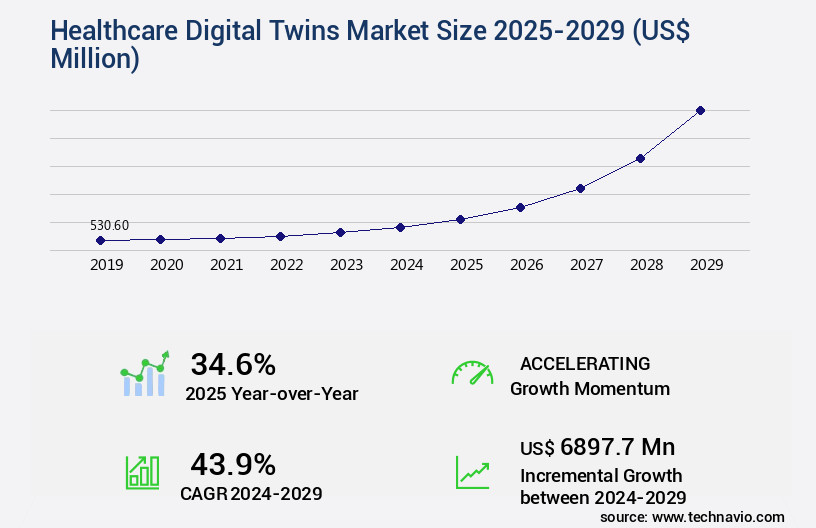
Get Key Insights on Market Forecast (PDF) Request Free Sample
How is the Healthcare Digital Twins Market Segmented?
The healthcare digital twins industry research report provides comprehensive data (region-wise segment analysis), with forecasts and estimates in "USD million" for the period 2025-2029, as well as historical data from 2019-2023 for the following segments.
- Component
- Application
- Personalized medicine
- Drug discovery and development
- Surgical planning
- Others
- Geography
- North America
- Europe
- APAC
- Australia
- China
- India
- Japan
- Rest of World (ROW)
By Component Insights
The software segment is estimated to witness significant growth during the forecast period.
The market is experiencing significant growth, with the software segment leading the charge. This segment encompasses a variety of applications designed to optimize healthcare delivery, improve patient care, and drive innovation. For instance, in August 2023, Altis Labs unveiled a novel digital twin technology for clinical trials, aiming to revolutionize the industry by reducing costs and enhancing efficiency. By employing digital twins, Altis Labs aspires to streamline clinical trial design, ultimately accelerating the development of new cancer treatments and bringing them to market faster.
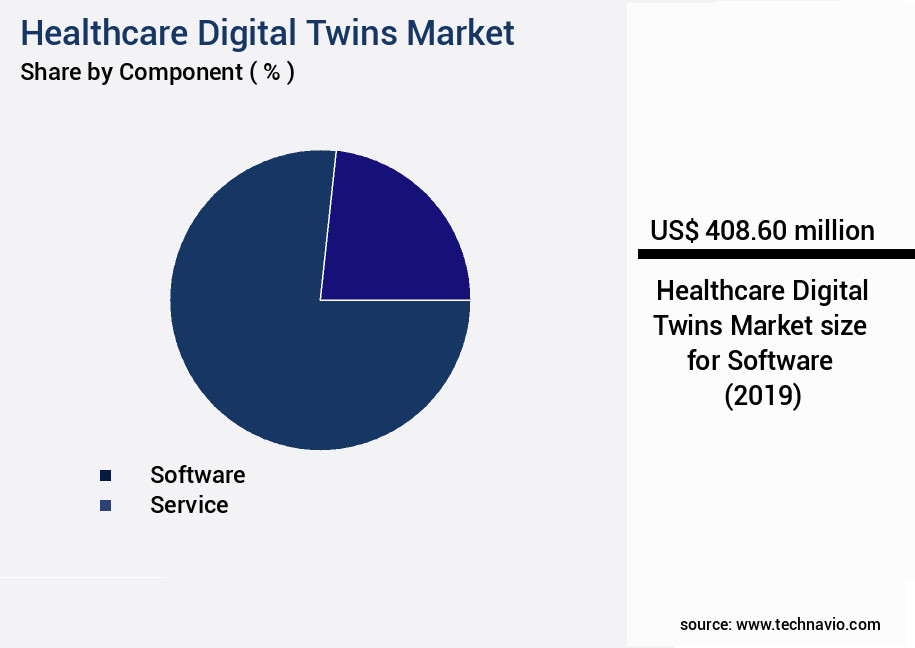
Request Free Sample
The Software segment was valued at USD 408.60 billion in 2019 and showed a gradual increase during the forecast period.
According to recent reports, digital twin technologies have the potential to reduce clinical trial costs by up to 30% and shorten trial durations by up to 50%. This breakthrough innovation also extends to personalized treatment planning, disease progression modeling, and real-time patient monitoring, enabling value-based care delivery and population health management. Furthermore, digital twins are being integrated into precision medicine platforms, allowing for genetic risk assessment, AI-driven diagnostics, and predictive analytics. With the integration of healthcare interoperability standards, medical imaging, and virtual physiological humans, digital twins are poised to revolutionize the healthcare landscape, improving patient safety, enhancing patient experience metrics, and optimizing healthcare resource allocation.
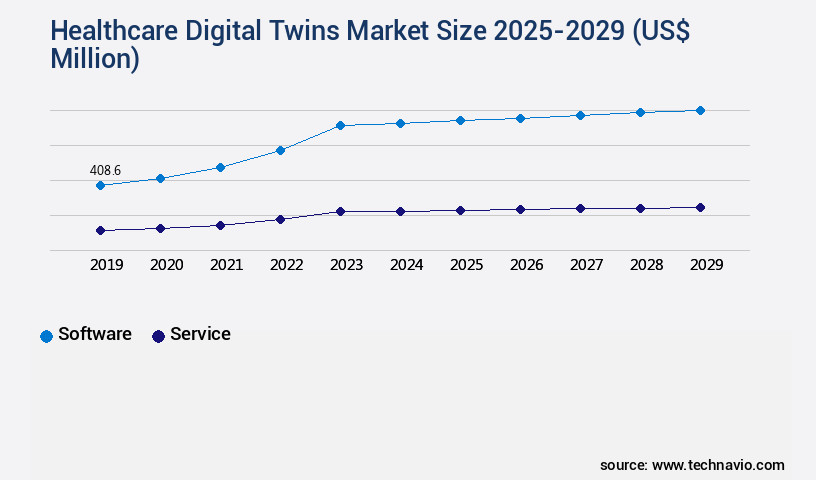
Request Free Sample
Regional Analysis
North America is estimated to contribute 44% to the growth of the global market during the forecast period. Technavio's analysts have elaborately explained the regional trends and drivers that shape the market during the forecast period.
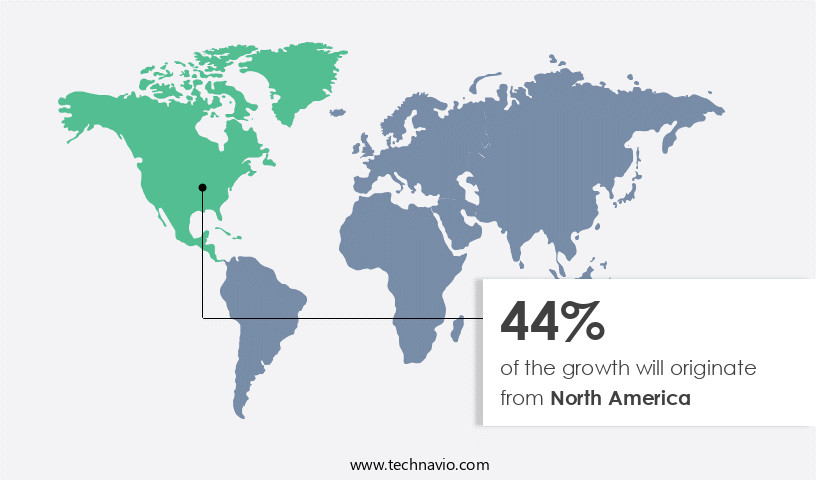
See How Healthcare Digital Twins Market Demand is Rising in North America Request Free Sample
The market in North America is witnessing notable expansion, fueled by substantial investments and groundbreaking initiatives. For instance, in October 2023, the National Institutes of Health (NIH) granted USD 3.14 million to Cleveland Clinic and Metro Health to utilize digital twins in addressing health disparities, underscoring the technology's potential to enhance healthcare equity and outcomes. This trend is further illustrated by the November 2024 launch of Acorn Biolabs' early access program for a personalized, topical skin and haircare treatment.
Derived from a person's hair follicle stem cells, this innovative solution exemplifies digital twin technology's application in personalized medicine and cosmetic treatments.
Market Dynamics
Our researchers analyzed the data with 2024 as the base year, along with the key drivers, trends, and challenges. A holistic analysis of drivers will help companies refine their marketing strategies to gain a competitive advantage.
The market is experiencing significant growth as the healthcare industry embraces digital transformation. This market encompasses AI-powered diagnostic tools integration, 3D anatomical model creation workflows, real-time physiological data analysis, personalized medicine algorithm development, predictive modeling of disease progression, clinical trial simulation software design, and patient data privacy protection measures. AI-driven diagnostic tools are integrated into digital twin systems to enhance accuracy and efficiency in diagnosis. These tools utilize machine learning algorithms, deep learning models, and natural language processing to analyze medical records and medical images. Computer vision techniques are employed in medical image analysis for early detection and diagnosis of diseases. Real-time physiological data analysis is another crucial aspect of healthcare digital twins. This involves the collection, processing, and analysis of data from various sources, including wearable devices and remote patient monitoring systems. Predictive modeling and disease progression analysis are essential for personalized medicine and evidence-based medicine. Healthcare workflow optimization strategies are also integrated into digital twin systems. Big data analytics applications and cloud-based data storage security protocols are used to ensure data interoperability and data governance framework implementation. Telemedicine platform integration and remote patient monitoring system design are critical components of digital twins, enabling healthcare providers to deliver care remotely and efficiently. Data privacy protection measures and clinical decision support system development are also essential components of healthcare digital twins. These systems use advanced security protocols and encryption techniques to protect patient data. Clinical decision support systems provide healthcare professionals with real-time access to patient data and evidence-based medicine recommendations, improving patient outcomes and reducing healthcare costs. In conclusion, the market is transforming the healthcare industry by enabling AI-powered diagnostic tools, real-time data analysis, personalized medicine, predictive modeling, and remote patient monitoring. With data privacy protection measures, clinical decision support systems, and telemedicine integration, digital twins are revolutionizing healthcare delivery and improving patient outcomes.
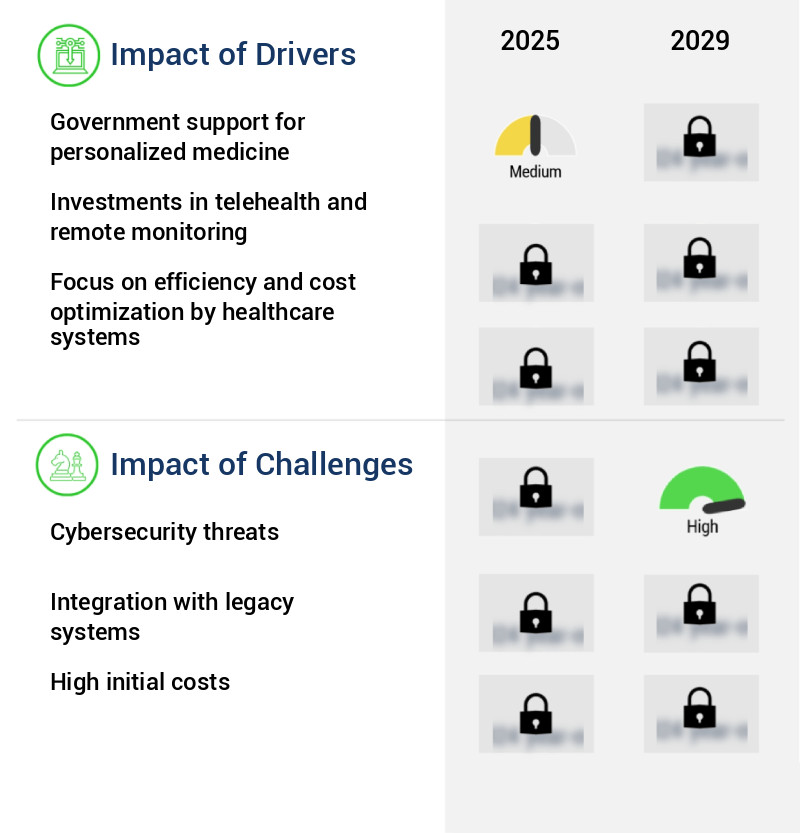
What are the key market drivers leading to the rise in the adoption of Healthcare Digital Twins Industry?
- Government support plays a crucial role in driving the growth of the personalized medicine market. This backing from regulatory authorities enables the development and implementation of individualized treatment plans, fostering innovation and investment in this sector.
- The market is experiencing significant growth and transformation, driven in part by government support for personalized medicine. The European Union (EU) is at the forefront of this movement, with the International Consortium for Personalized Medicine (ICPerMed) spearheading innovation and digitalization in this field. The consortium, comprised of European and international partners, aims to advance personalized medicine through collaborative efforts. Recently, China has joined the consortium, expanding its reach and fostering international partnerships. The IC2PerMed project, a key initiative, focuses on data management, security, and international collaborations, underscoring China's active investment in this sector.
- In the US, government backing for personalized medicine is evident through ongoing investments and regulatory approvals. The market is poised for continued expansion, with the EU and US leading the charge in government support for personalized medicine.
What are the market trends shaping the Healthcare Digital Twins Industry?
- The use of AI-generated digital twins is becoming the trend in personalized medicine.
- The market is undergoing a significant evolution, driven by advancements in artificial intelligence and genomics. This technological innovation allows for the creation of digital twins at the cellular level, integrating extensive medical and physiological data. These digital twins, which include tissues, organs, and biokinetic information, offer a detailed perspective on disease progression. The use of AI-generated digital twins enables the customization of treatment plans based on individual patient profiles, ensuring precision in medical treatments.
- By simulating various medical scenarios, these digital twins enhance the accuracy of therapies, catering to the unique needs of each patient. The integration of AI in healthcare is revolutionizing personalized medicine, offering a more targeted and effective approach to patient care.
What challenges does the Healthcare Digital Twins Industry face during its growth?
- Cybersecurity threats pose a significant challenge to the growth of various industries by putting businesses at risk of data breaches, financial losses, and reputational damage. It is crucial for organizations to prioritize cybersecurity measures to mitigate these risks and ensure the protection of sensitive information.
- The market is experiencing significant growth and adoption across various sectors due to the potential for improved efficiency, accuracy, and patient outcomes. Digital twins, virtual replicas of physical systems, are increasingly being used in healthcare to enhance diagnosis, treatment planning, and operational optimization. For instance, digital twins can help simulate complex medical procedures, allowing for better preparation and training. Moreover, they can facilitate remote monitoring and real-time analysis of patient data, enabling timely interventions and personalized care. However, the market faces a persistent challenge from cybersecurity threats. Over one-third of healthcare organizations worldwide have experienced ransomware attacks, causing disruptions to critical functions and leading to delays in patient care and financial losses.
- In 2024, Change Healthcare in the US was among the victims of such attacks, which impacted claims processing and prescription drug processing. These incidents underscore the importance of robust cybersecurity measures to protect sensitive healthcare data and systems.
Exclusive Technavio Analysis on Customer Landscape
The healthcare digital twins market forecasting report includes the adoption lifecycle of the market, covering from the innovator's stage to the laggard's stage. It focuses on adoption rates in different regions based on penetration. Furthermore, the healthcare digital twins market report also includes key purchase criteria and drivers of price sensitivity to help companies evaluate and develop their market growth analysis strategies.
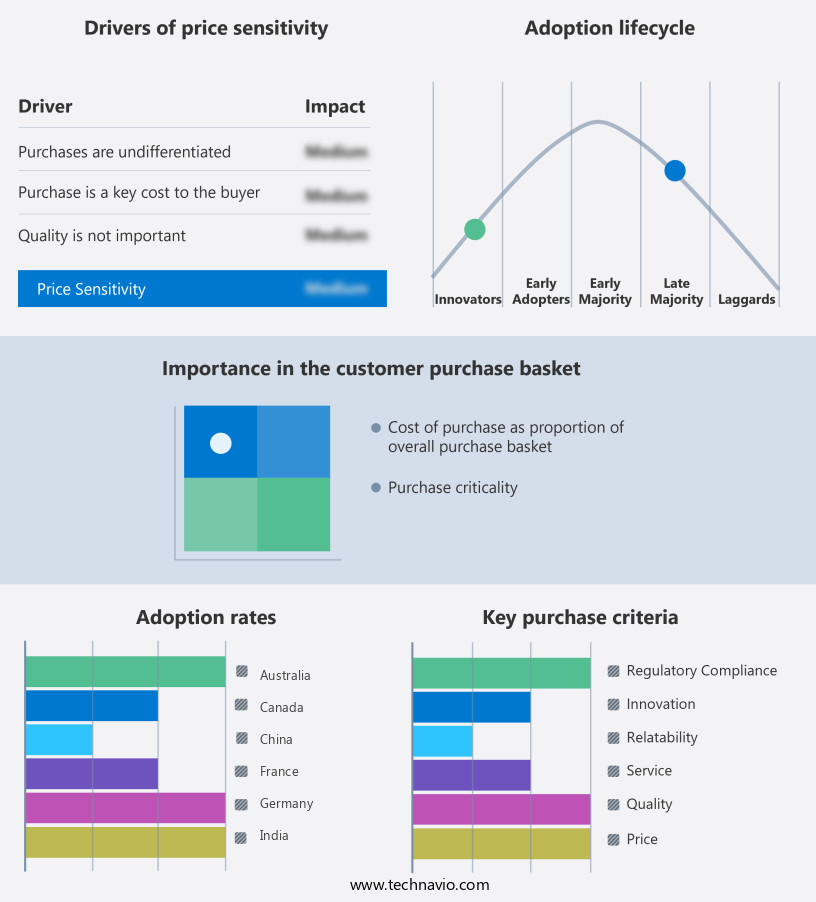
Customer Landscape of Healthcare Digital Twins Industry
Competitive Landscape
Companies are implementing various strategies, such as strategic alliances, healthcare digital twins market forecast, partnerships, mergers and acquisitions, geographical expansion, and product/service launches, to enhance their presence in the industry.
ANSYS Inc. - Healthcare digital twins, a cutting-edge innovation, optimize processes and enhance decision-making in the healthcare sector.
The industry research and growth report includes detailed analyses of the competitive landscape of the market and information about key companies, including:
- ANSYS Inc.
- Atos SE
- Dassault Systemes SE
- Exactcure
- Faststream Technologies
- GE Healthcare Technologies Inc.
- International Business Machines Corp.
- Koninklijke Philips N.V.
- Microsoft Corp
- NVIDIA Corp.
- Oracle Corp
- Predictiv Care Inc.
- Rescale Inc.
- Siemens Healthineers AG
- ThoughtWire
- Twins Digital Services India Pvt Ltd
- Unlearn.ai Inc
- Verto Inc.
Qualitative and quantitative analysis of companies has been conducted to help clients understand the wider business environment as well as the strengths and weaknesses of key industry players. Data is qualitatively analyzed to categorize companies as pure play, category-focused, industry-focused, and diversified; it is quantitatively analyzed to categorize companies as dominant, leading, strong, tentative, and weak.
Recent Development and News in Healthcare Digital Twins Market
- In January 2024, Medtronic, a leading medical technology company, announced the launch of its new digital twin solution, "Harmony Digital Twin," designed to improve patient care and streamline clinical workflows for cardiology and respiratory therapy. This solution was showcased at the Consumer Electronics Show (CES) 2024 (Sources: Medtronic Press Release, CES 2024 Official Website).
- In March 2024, IBM and Cerner Corporation, a major health care information technology company, entered into a strategic partnership to integrate IBM's Watson AI capabilities into Cerner's digital twin solutions. This collaboration aimed to enhance patient care and clinical decision-making by providing real-time insights from vast health data sets (Sources: IBM Press Release, Cerner Corporation Press Release).
- In May 2024, Siemens Healthineers, a leading medical technology company, secured a significant investment of € 1.3 billion (USD 1.45 billion) from Siemens AG to expand its digital health business, including the development and commercialization of digital twin solutions (Sources: Siemens Healthineers Press Release, Siemens AG Annual Report).
- In April 2025, the U.S. Food and Drug Administration (FDA) granted clearance for the use of GE Healthcare's digital twin solution, "Model X," to simulate and optimize heart function, aiding in the planning and execution of complex cardiac procedures (Sources: FDA Press Release, GE Healthcare Press Release).
Dive into Technavio's robust research methodology, blending expert interviews, extensive data synthesis, and validated models for unparalleled Healthcare Digital Twins Market insights. See full methodology.
|
Market Scope
|
|
Report Coverage
|
Details
|
|
Page number
|
206
|
|
Base year
|
2024
|
|
Historic period
|
2019-2023 |
|
Forecast period
|
2025-2029
|
|
Growth momentum & CAGR
|
Accelerate at a CAGR of 43.9%
|
|
Market growth 2025-2029
|
USD 6897.7 million
|
|
Market structure
|
Fragmented
|
|
YoY growth 2024-2025(%)
|
34.6
|
|
Key countries
|
US, Germany, UK, China, Japan, India, France, Canada, Australia, and Italy
|
|
Competitive landscape
|
Leading Companies, Market Positioning of Companies, Competitive Strategies, and Industry Risks
|
Request Free Sample
Research Analyst Overview
- The market continues to evolve, driven by the increasing demand for personalized treatment planning, healthcare cost reduction, and workflow optimization. This market encompasses various applications, including drug discovery platforms, precision medicine platforms, public health surveillance, and value-based care delivery. For instance, a leading pharmaceutical company reported a 25% reduction in drug development costs by implementing a digital twin for preclinical testing. Moreover, the integration of interoperability standards, real-time patient monitoring, and disease progression modeling enables healthcare providers to deliver more effective treatment plans and improve patient safety. The industry anticipates a 20% growth in digital twin adoption over the next five years, as healthcare organizations increasingly adopt AI-driven diagnostics, healthcare data visualization, and predictive analytics.
- Additionally, the integration of medical imaging and genetic risk assessment into digital twins enhances the potential for personalized medicine approaches and treatment efficacy evaluation. The ongoing development of cloud-based healthcare platforms and clinical trial simulations further streamlines the research and development process, enabling more efficient healthcare resource allocation. The application of digital twins extends beyond the clinical setting, with surgical planning software and 3D organ modeling revolutionizing the field of precision medicine. Virtual physiological humans, patient data simulation, and population health management offer valuable insights into disease progression and patient experience metrics, ultimately contributing to the ongoing improvement of patient care.
What are the Key Data Covered in this Healthcare Digital Twins Market Research and Growth Report?
-
What is the expected growth of the Healthcare Digital Twins Market between 2025 and 2029?
-
What segmentation does the market report cover?
-
The report is segmented by Component (Software and Service), Application (Personalized medicine, Drug discovery and development, Surgical planning, and Others), and Geography (North America, Europe, Asia, and Rest of World (ROW))
-
Which regions are analyzed in the report?
-
What are the key growth drivers and market challenges?
-
Who are the major players in the Healthcare Digital Twins Market?
-
ANSYS Inc., Atos SE, Dassault Systemes SE, Exactcure, Faststream Technologies, GE Healthcare Technologies Inc., International Business Machines Corp., Koninklijke Philips N.V., Microsoft Corp, NVIDIA Corp., Oracle Corp, Predictiv Care Inc., Rescale Inc., Siemens Healthineers AG, ThoughtWire, Twins Digital Services India Pvt Ltd, Unlearn.ai Inc, and Verto Inc.
Market Research Insights
- The market encompasses various applications, including pharmacodynamic and pharmacokinetic modeling, remote monitoring platforms, and disease modeling techniques. This market continues to evolve, integrating advanced technologies such as natural language processing, machine learning, and deep learning. According to recent reports, the market is expected to grow by over 20% annually. For instance, remote monitoring platforms have shown significant outcomes in improving patient care. A study revealed a 30% reduction in hospital readmissions by implementing a remote monitoring system. Furthermore, the integration of telemedicine and wearable sensor data has facilitated more effective treatment plans and better patient outcomes.
- Despite the market's promising growth, healthcare data governance and data privacy regulations remain crucial considerations. The integration of federated learning healthcare and data interoperability solutions aims to address these concerns while ensuring data security and anonymization. These advancements are paving the way for a more connected and efficient healthcare ecosystem.
We can help! Our analysts can customize this healthcare digital twins market research report to meet your requirements.
Get in touch
1 Executive Summary
- 1.1 Market overview
- Executive Summary - Chart on Market Overview
- Executive Summary - Data Table on Market Overview
- Executive Summary - Chart on Global Market Characteristics
- Executive Summary - Chart on Market by Geography
- Executive Summary - Chart on Market Segmentation by Component
- Executive Summary - Chart on Market Segmentation by Application
- Executive Summary - Chart on Incremental Growth
- Executive Summary - Data Table on Incremental Growth
- Executive Summary - Chart on Company Market Positioning
2 Technavio Analysis
- 2.1 Analysis of price sensitivity, lifecycle, customer purchase basket, adoption rates, and purchase criteria
- Analysis of price sensitivity, lifecycle, customer purchase basket, adoption rates, and purchase criteria
- 2.2 Criticality of inputs and Factors of differentiation
- Overview on criticality of inputs and factors of differentiation
- 2.3 Factors of disruption
- Overview on factors of disruption
- 2.4 Impact of drivers and challenges
- Impact of drivers and challenges in 2024 and 2029
3 Market Landscape
- 3.1 Market ecosystem
- Parent Market
- Data Table on - Parent Market
- 3.2 Market characteristics
- Market characteristics analysis
4 Market Sizing
- 4.1 Market definition
- Offerings of companies included in the market definition
- 4.2 Market segment analysis
- 4.4 Market outlook: Forecast for 2024-2029
- Chart on Global - Market size and forecast 2024-2029 ($ million)
- Data Table on Global - Market size and forecast 2024-2029 ($ million)
- Chart on Global Market: Year-over-year growth 2024-2029 (%)
- Data Table on Global Market: Year-over-year growth 2024-2029 (%)
5 Historic Market Size
- 5.1 Global Healthcare Digital Twins Market 2019 - 2023
- Historic Market Size - Data Table on Global Healthcare Digital Twins Market 2019 - 2023 ($ million)
- 5.2 Component segment analysis 2019 - 2023
- Historic Market Size - Component Segment 2019 - 2023 ($ million)
- 5.3 Application segment analysis 2019 - 2023
- Historic Market Size - Application Segment 2019 - 2023 ($ million)
- 5.4 Geography segment analysis 2019 - 2023
- Historic Market Size - Geography Segment 2019 - 2023 ($ million)
- 5.5 Country segment analysis 2019 - 2023
- Historic Market Size - Country Segment 2019 - 2023 ($ million)
6 Qualitative Analysis
- 6.1 Impact of AI in the Global Healthcare Digital Twins Market
7 Five Forces Analysis
- 7.1 Five forces summary
- Five forces analysis - Comparison between 2024 and 2029
- 7.2 Bargaining power of buyers
- Bargaining power of buyers - Impact of key factors 2024 and 2029
- 7.3 Bargaining power of suppliers
- Bargaining power of suppliers - Impact of key factors in 2024 and 2029
- 7.4 Threat of new entrants
- Threat of new entrants - Impact of key factors in 2024 and 2029
- 7.5 Threat of substitutes
- Threat of substitutes - Impact of key factors in 2024 and 2029
- 7.6 Threat of rivalry
- Threat of rivalry - Impact of key factors in 2024 and 2029
- 7.7 Market condition
- Chart on Market condition - Five forces 2024 and 2029
8 Market Segmentation by Component
- 8.1 Market segments
- Chart on Component - Market share 2024-2029 (%)
- Data Table on Component - Market share 2024-2029 (%)
- 8.2 Comparison by Component
- Chart on Comparison by Component
- Data Table on Comparison by Component
- 8.3 Software - Market size and forecast 2024-2029
- Chart on Software - Market size and forecast 2024-2029 ($ million)
- Data Table on Software - Market size and forecast 2024-2029 ($ million)
- Chart on Software - Year-over-year growth 2024-2029 (%)
- Data Table on Software - Year-over-year growth 2024-2029 (%)
- 8.4 Service - Market size and forecast 2024-2029
- Chart on Service - Market size and forecast 2024-2029 ($ million)
- Data Table on Service - Market size and forecast 2024-2029 ($ million)
- Chart on Service - Year-over-year growth 2024-2029 (%)
- Data Table on Service - Year-over-year growth 2024-2029 (%)
- 8.5 Market opportunity by Component
- Market opportunity by Component ($ million)
- Data Table on Market opportunity by Component ($ million)
9 Market Segmentation by Application
- 9.1 Market segments
- Chart on Application - Market share 2024-2029 (%)
- Data Table on Application - Market share 2024-2029 (%)
- 9.2 Comparison by Application
- Chart on Comparison by Application
- Data Table on Comparison by Application
- 9.3 Personalized medicine - Market size and forecast 2024-2029
- Chart on Personalized medicine - Market size and forecast 2024-2029 ($ million)
- Data Table on Personalized medicine - Market size and forecast 2024-2029 ($ million)
- Chart on Personalized medicine - Year-over-year growth 2024-2029 (%)
- Data Table on Personalized medicine - Year-over-year growth 2024-2029 (%)
- 9.4 Drug discovery and development - Market size and forecast 2024-2029
- Chart on Drug discovery and development - Market size and forecast 2024-2029 ($ million)
- Data Table on Drug discovery and development - Market size and forecast 2024-2029 ($ million)
- Chart on Drug discovery and development - Year-over-year growth 2024-2029 (%)
- Data Table on Drug discovery and development - Year-over-year growth 2024-2029 (%)
- 9.5 Surgical planning - Market size and forecast 2024-2029
- Chart on Surgical planning - Market size and forecast 2024-2029 ($ million)
- Data Table on Surgical planning - Market size and forecast 2024-2029 ($ million)
- Chart on Surgical planning - Year-over-year growth 2024-2029 (%)
- Data Table on Surgical planning - Year-over-year growth 2024-2029 (%)
- 9.6 Others - Market size and forecast 2024-2029
- Chart on Others - Market size and forecast 2024-2029 ($ million)
- Data Table on Others - Market size and forecast 2024-2029 ($ million)
- Chart on Others - Year-over-year growth 2024-2029 (%)
- Data Table on Others - Year-over-year growth 2024-2029 (%)
- 9.7 Market opportunity by Application
- Market opportunity by Application ($ million)
- Data Table on Market opportunity by Application ($ million)
10 Customer Landscape
- 10.1 Customer landscape overview
- Analysis of price sensitivity, lifecycle, customer purchase basket, adoption rates, and purchase criteria
11 Geographic Landscape
- 11.1 Geographic segmentation
- Chart on Market share by geography 2024-2029 (%)
- Data Table on Market share by geography 2024-2029 (%)
- 11.2 Geographic comparison
- Chart on Geographic comparison
- Data Table on Geographic comparison
- 11.3 North America - Market size and forecast 2024-2029
- Chart on North America - Market size and forecast 2024-2029 ($ million)
- Data Table on North America - Market size and forecast 2024-2029 ($ million)
- Chart on North America - Year-over-year growth 2024-2029 (%)
- Data Table on North America - Year-over-year growth 2024-2029 (%)
- 11.4 Europe - Market size and forecast 2024-2029
- Chart on Europe - Market size and forecast 2024-2029 ($ million)
- Data Table on Europe - Market size and forecast 2024-2029 ($ million)
- Chart on Europe - Year-over-year growth 2024-2029 (%)
- Data Table on Europe - Year-over-year growth 2024-2029 (%)
- 11.5 Asia - Market size and forecast 2024-2029
- Chart on Asia - Market size and forecast 2024-2029 ($ million)
- Data Table on Asia - Market size and forecast 2024-2029 ($ million)
- Chart on Asia - Year-over-year growth 2024-2029 (%)
- Data Table on Asia - Year-over-year growth 2024-2029 (%)
- 11.6 Rest of World (ROW) - Market size and forecast 2024-2029
- Chart on Rest of World (ROW) - Market size and forecast 2024-2029 ($ million)
- Data Table on Rest of World (ROW) - Market size and forecast 2024-2029 ($ million)
- Chart on Rest of World (ROW) - Year-over-year growth 2024-2029 (%)
- Data Table on Rest of World (ROW) - Year-over-year growth 2024-2029 (%)
- 11.7 US - Market size and forecast 2024-2029
- Chart on US - Market size and forecast 2024-2029 ($ million)
- Data Table on US - Market size and forecast 2024-2029 ($ million)
- Chart on US - Year-over-year growth 2024-2029 (%)
- Data Table on US - Year-over-year growth 2024-2029 (%)
- 11.8 Germany - Market size and forecast 2024-2029
- Chart on Germany - Market size and forecast 2024-2029 ($ million)
- Data Table on Germany - Market size and forecast 2024-2029 ($ million)
- Chart on Germany - Year-over-year growth 2024-2029 (%)
- Data Table on Germany - Year-over-year growth 2024-2029 (%)
- 11.9 UK - Market size and forecast 2024-2029
- Chart on UK - Market size and forecast 2024-2029 ($ million)
- Data Table on UK - Market size and forecast 2024-2029 ($ million)
- Chart on UK - Year-over-year growth 2024-2029 (%)
- Data Table on UK - Year-over-year growth 2024-2029 (%)
- 11.10 China - Market size and forecast 2024-2029
- Chart on China - Market size and forecast 2024-2029 ($ million)
- Data Table on China - Market size and forecast 2024-2029 ($ million)
- Chart on China - Year-over-year growth 2024-2029 (%)
- Data Table on China - Year-over-year growth 2024-2029 (%)
- 11.11 Japan - Market size and forecast 2024-2029
- Chart on Japan - Market size and forecast 2024-2029 ($ million)
- Data Table on Japan - Market size and forecast 2024-2029 ($ million)
- Chart on Japan - Year-over-year growth 2024-2029 (%)
- Data Table on Japan - Year-over-year growth 2024-2029 (%)
- 11.12 India - Market size and forecast 2024-2029
- Chart on India - Market size and forecast 2024-2029 ($ million)
- Data Table on India - Market size and forecast 2024-2029 ($ million)
- Chart on India - Year-over-year growth 2024-2029 (%)
- Data Table on India - Year-over-year growth 2024-2029 (%)
- 11.13 France - Market size and forecast 2024-2029
- Chart on France - Market size and forecast 2024-2029 ($ million)
- Data Table on France - Market size and forecast 2024-2029 ($ million)
- Chart on France - Year-over-year growth 2024-2029 (%)
- Data Table on France - Year-over-year growth 2024-2029 (%)
- 11.14 Canada - Market size and forecast 2024-2029
- Chart on Canada - Market size and forecast 2024-2029 ($ million)
- Data Table on Canada - Market size and forecast 2024-2029 ($ million)
- Chart on Canada - Year-over-year growth 2024-2029 (%)
- Data Table on Canada - Year-over-year growth 2024-2029 (%)
- 11.15 Australia - Market size and forecast 2024-2029
- Chart on Australia - Market size and forecast 2024-2029 ($ million)
- Data Table on Australia - Market size and forecast 2024-2029 ($ million)
- Chart on Australia - Year-over-year growth 2024-2029 (%)
- Data Table on Australia - Year-over-year growth 2024-2029 (%)
- 11.16 Italy - Market size and forecast 2024-2029
- Chart on Italy - Market size and forecast 2024-2029 ($ million)
- Data Table on Italy - Market size and forecast 2024-2029 ($ million)
- Chart on Italy - Year-over-year growth 2024-2029 (%)
- Data Table on Italy - Year-over-year growth 2024-2029 (%)
- 11.17 Market opportunity by geography
- Market opportunity by geography ($ million)
- Data Tables on Market opportunity by geography ($ million)
12 Drivers, Challenges, and Opportunity/Restraints
- 12.3 Impact of drivers and challenges
- Impact of drivers and challenges in 2024 and 2029
- 12.4 Market opportunities/restraints
13 Competitive Landscape
- 13.2 Competitive Landscape
- Overview on criticality of inputs and factors of differentiation
- 13.3 Landscape disruption
- Overview on factors of disruption
- 13.4 Industry risks
- Impact of key risks on business
14 Competitive Analysis
- 14.2 Company ranking index
- 14.3 Market positioning of companies
- Matrix on companies position and classification
- 14.4 ANSYS Inc.
- ANSYS Inc. - Overview
- ANSYS Inc. - Product / Service
- ANSYS Inc. - Key news
- ANSYS Inc. - Key offerings
- SWOT
- 14.5 Atos SE
- Atos SE - Overview
- Atos SE - Business segments
- Atos SE - Key news
- Atos SE - Key offerings
- Atos SE - Segment focus
- SWOT
- 14.6 Dassault Systemes SE
- Dassault Systemes SE - Overview
- Dassault Systemes SE - Product / Service
- Dassault Systemes SE - Key news
- Dassault Systemes SE - Key offerings
- SWOT
- 14.7 Exactcure
- Exactcure - Overview
- Exactcure - Product / Service
- Exactcure - Key offerings
- SWOT
- 14.8 Faststream Technologies
- Faststream Technologies - Overview
- Faststream Technologies - Product / Service
- Faststream Technologies - Key offerings
- SWOT
- 14.9 GE Healthcare Technologies Inc.
- GE Healthcare Technologies Inc. - Overview
- GE Healthcare Technologies Inc. - Business segments
- GE Healthcare Technologies Inc. - Key news
- GE Healthcare Technologies Inc. - Key offerings
- GE Healthcare Technologies Inc. - Segment focus
- SWOT
- 14.10 International Business Machines Corp.
- International Business Machines Corp. - Overview
- International Business Machines Corp. - Business segments
- International Business Machines Corp. - Key news
- International Business Machines Corp. - Key offerings
- International Business Machines Corp. - Segment focus
- SWOT
- 14.11 Koninklijke Philips N.V.
- Koninklijke Philips N.V. - Overview
- Koninklijke Philips N.V. - Business segments
- Koninklijke Philips N.V. - Key news
- Koninklijke Philips N.V. - Key offerings
- Koninklijke Philips N.V. - Segment focus
- SWOT
- 14.12 Microsoft Corp
- Microsoft Corp - Overview
- Microsoft Corp - Business segments
- Microsoft Corp - Key news
- Microsoft Corp - Key offerings
- Microsoft Corp - Segment focus
- SWOT
- 14.13 NVIDIA Corp.
- NVIDIA Corp. - Overview
- NVIDIA Corp. - Business segments
- NVIDIA Corp. - Key news
- NVIDIA Corp. - Key offerings
- NVIDIA Corp. - Segment focus
- SWOT
- 14.14 Oracle Corp
- Oracle Corp - Overview
- Oracle Corp - Business segments
- Oracle Corp - Key news
- Oracle Corp - Key offerings
- Oracle Corp - Segment focus
- SWOT
- 14.15 Siemens Healthineers AG
- Siemens Healthineers AG - Overview
- Siemens Healthineers AG - Business segments
- Siemens Healthineers AG - Key news
- Siemens Healthineers AG - Key offerings
- Siemens Healthineers AG - Segment focus
- SWOT
- 14.16 Twins Digital Services India Pvt Ltd
- Twins Digital Services India Pvt Ltd - Overview
- Twins Digital Services India Pvt Ltd - Product / Service
- Twins Digital Services India Pvt Ltd - Key offerings
- SWOT
- 14.17 Unlearn.ai Inc
- Unlearn.ai Inc - Overview
- Unlearn.ai Inc - Product / Service
- Unlearn.ai Inc - Key offerings
- SWOT
- 14.18 Verto Inc.
- Verto Inc. - Overview
- Verto Inc. - Product / Service
- Verto Inc. - Key offerings
- SWOT
15 Appendix
- 15.2 Inclusions and exclusions checklist
- Inclusions checklist
- Exclusions checklist
- 15.3 Currency conversion rates for US$
- Currency conversion rates for US$
- 15.4 Research methodology
- 15.7 Validation techniques employed for market sizing
- Validation techniques employed for market sizing
- 15.9 360 degree market analysis
- 360 degree market analysis
- 15.10 List of abbreviations







![]() Get the report (PDF) sent to your email within minutes.
Get the report (PDF) sent to your email within minutes.
Complimentary full Excel data with your report purchase.